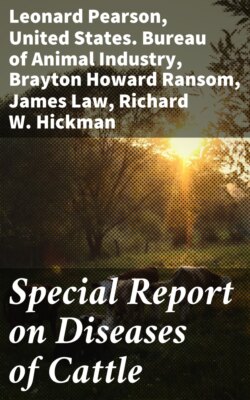Читать книгу Special Report on Diseases of Cattle - Lowe - Страница 107
На сайте Литреса книга снята с продажи.
INJURY TO THE HEART BY FOREIGN BODIES.
ОглавлениеCattle are addicted to the habit of chewing and swallowing many objects not intended as articles of food. Every veterinarian of experience has met with instances to remind him of this, and it is well known to butchers. Among the great variety of things that have thus found their way into the stomachs of cattle the following have been noticed: Finger rings, knitting needles, old shoes, table knives, wood, pieces of leather, pieces of wire, buttons, hairpins, brushes, nails, coins, etc. The more sharply pointed objects sometimes penetrate the wall of the stomach, in some cases causing gastric irritation enough to produce indigestion, gradually work their way through the diaphragm toward the heart, pierce the pericardium (bag inclosing the heart), wound the heart, and thus prove fatal to the animal. Cases are recorded in which the foreign body has actually worked its way into one of the cavities of the heart. Instances are known, however, in which the object took a different course, and finally worked its way toward the surface and was extracted from the wall of the chest. While it is possible that the foreign body may pierce the wall at different parts of the alimentary canal, as it frequently does that of the rumen (paunch), it is thought that in most cases it passes through the wall of the reticulum (smaller honeycombed compartment, or second stomach) and is drawn toward the heart by the suctionlike action of the chest. Post-mortem examinations have demonstrated the course it pursued, as adhesions and other results of the inflammation it caused were plainly to be seen. All manner of symptoms may precede those showing involvement of the heart, depending upon the location of the foreign body and the extent of inflammation caused by it. Severe indigestion may occur; stiffness and difficulty in moving about owing to the prods of the sharp body following muscular contraction; pain on pressure over the front, lower, or right side of the abdomen; coughing and difficult, quick breathing. In most cases the foreign body does not penetrate to the heart, nor even to the pericardium.
Symptoms.—The symptoms are as follows: The animal is disinclined to move actively, the step is restricted and cautious, sudden motion causes grunting, the attitude is constrained, the feet are drawn somewhat together, the back is arched, the face has an anxious expression. If the disease is of several days' standing, there is likely to be soft swelling (edema) beneath the neck, in the dewlap, and under the chest, between the fore legs. Breathing is short and difficult; it may clearly be painful. The pulse is rapid, 80 to 120 per minute. The muscles quiver as though the animal were cold. Rumination and appetite are depressed or checked. The dung is hard, and to void it appears to cause pain. These symptoms usually develop gradually, and, of course, they vary considerably in different animals, depending upon the size and location of the foreign body and the irritation it causes.
As a matter of course, in such cases treatment is useless, but when it is possible to diagnose correctly the animal could be turned over to the butcher before the flesh becomes unfit for use; that is, before there is more than a little suppuration and before there is fever. Knowing that cattle are prone to swallow such objects, ordinary care may be taken in keeping their surroundings as free of them as possible.
